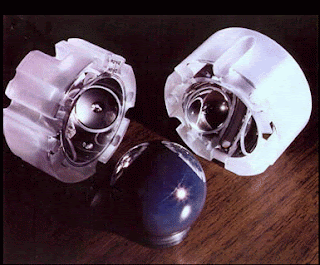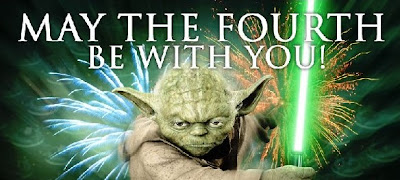So this weeks lesson is about the Sun. Our home star is the very thing that makes life possible here on Earth. At a mere 93 million miles away in the center of our solar system, the Sun dominates our sky. By comparison, the next closest star, Proxima Centauri, is just over four light years away. The warmth of the Sun's glow provides a climate on Earth perfect for life. It's closeness also makes it the easiest and best studied star in the Universe.
 |
| The Sun as seen from Earth's surface. (Wiki) |
For as close and well studied as the Sun is, we still still don't know a whole lot. But astronomers are working hard on it every day. In fact, knowing that we don't know things about the Sun is helping us to look harder for more and more answers. But, what we to know is simply amazing. The Sun is a dynamic changing body, the intricacies are beautiful when seen, and the power is awe inspiring.
Our Sun is a middle-aged
yellow dwarf star, designated as a G V star. The Sun is approximately 4.6 billion years old, with about 6.3 billion left. There are some misnomers in calling it a yellow dwarf. The first is that the Sun isn't actually yellow, it emits white light. The Sun is also huge, it makes up 99.86% of the mass of the Solar System and has a diameter of 1.4 million kilometers, that's equivalent to 109 Earths lined up side by side. Volume-wise, the Sun is 1.4 x 10
27 cubic meters, big enough to fit 1.3 million Earths inside with room to spare.
 |
| Our Sun is a Yellow Dwarf. |
When compared to other stars, the Sun is tiny next to the largest known stars. VY Canis Majoris has an upper limit of more then 2,100 times the size of the Sun, it's surface would extend out past the orbit of Saturn. Other estimates say VY Canis Majoris is smaller, but the surface would still extend out around the orbit of Mars. But these huge stars are really rare, in fact, small stars dominate the cosmos and it is now known that the Sun is larger than 80% of stars in the Milky Way. For a long time people have been saying the Sun is an average star, but it is anything but that, only about 10% of stars are like the Sun.
Another unique thing about the Sun is that it is a Population I star, meaning it is metal-rich. (In astronomy jargon, anything that isn't hydrogen or helium is called a metal, it makes little sense, but it makes the universe sound more awesome.) These metals were seeded by the shockwaves of nearby supernovae that triggered the formation of the Sun. The other classification is Population II stars, which are metal poor, but more on that another time, I am thinking of doing star classifications next week.
All these metals, like carbon and oxygen, make up a whooping less the 2% of the Sun's mass. Three quarters of the mass is hydrogen, and the remainder is helium. Hydrogen is the simplest and most common element in the Solar System, as well as the Universe. Inside stars like the Sun, fusion takes place that creates helium and heavier elements up to iron. Everything heavier then iron needs a supernova-type event to be created.
Needless to say, the Sun is also extremely hot. As fusion takes place it generates a lot of heat that gives the Sun life. Its surface (photosphere) temperature is roughly 5800 K based on measurements. Other layers vary in temperature, and are harder to study since we cannot see into the Sun, but modelling suggests the core of the Sun is a roaring 15,000,000 K. Not an ideal place to spend summer vacation.
 |
| Earth to Sunspot size comparison. (Source) |
This heat and pressure causes the matter that makes up the Sun exist in the fourth state of matter, plasma. The plasma flows along magnetic fields that weave complexly through the Sun. The hot plasma rises to the surface and creates a boiled look on the surface of the Sun, a granulated texture, and as the plasma cools, falls back into the Sun. Often a large region becomes isolated because of the magnetic fields, and as the plasma in this region cools, it appears darker then the surrounding area. These are sunspots, and although cool regions they are still a blistering 3700 K. Many are as big as Earth!
 |
| Solar Prominence with Jupiter and Earth for comparison. (Wiki) |
Sometimes these magnetic fields snap out into space an draw plasma along in arcs and lines. When looking at the chromosphere of the Sun through a safe telescope, these appear as filaments and prominences. If they break away from the Sun, they become known as solar flares, small plasma storms that fling out into space. These can potentially be hazardous to Earth, but our magnetic field protects us from most damage. The magnetic activity that causes sunspots and flaring is cyclic, running about 11 years, and we are currently heading into a peak.
 |
| Cartoon of the formation of CME, once the center point, it pushes out the CME. (NASA) |
There is another type of storm that comes from the Sun, known as a coronal mass ejection, or CME for short. These are a lot larger and potentially more dangerous. These originate in one of the Sun's outer layers, the corona, and are massive blast of the solar wind, light plasma, and electromagnetic radiation. These are caused by similar magnetic activity to that which causes solar flares, but on a much more massive scale. They happen often and generally are not dangerous, but occasionally large and powerful ones can occur. These large CMEs are capable of disrupting communications and power networks on Earth.
 |
| Image of a CME launching from the Sun. (NASA) |
The CMEs and flares are propagated throughout the Solar System on the solar wind. The solar wind is made up of charged particles ejected from the Sun. Their high kinetic energy allows them to escape the gravity of the Sun. The solar wind is generally what causes aurora and the plasma tails of comets. It exerts a slight push, since the wind has a mass.
 |
| I like that this image already has all the info in it already and I don't need to make a caption... oh.. |
The wind inflates a vast bubble around the Solar System in the interstellar medium. This bubble is known as the heliosphere, and is the out-most atmosphere of the Sun. (Yes, you reside in the Sun's atmosphere.) The edge of this is currently being studied to build a fuller model of our Sun. Currently, the Voyager probes are crossing the boundary into interstellar space, which appears to be just inside of the Oort cloud which surrounds the Solar System.
The idea of making a model of the Sun seems like an easy thing to do, but as astronomers have learned more about the Sun, the more questions arise. It is incredible complex, and we have very little understanding of the Sun's interior. One of the most ambitious projects I heard about when I studied astronomy was building a simulation from the surface of the Sun to the edge of interstellar space. It isn't a thing that has been done yet, and the computational power may not even be available. It would have to cover over 13,463,808,363 km.
 |
| What our Solar System might look like on the outside. (NASA) |
I hope you now have a much better understanding of our closest star, the Sun. More is being learned about it all the time. Several observatories are working on studying solar storms and perhaps ways to predict them so we can be prepared when they hit. We also learn more about the origin and composition of our home. It is also important to understand that the Sun is changing over time, and is getting hotter. We can study to understand the future of the Sun, and its affects on the Earth (spoiler alert: all life on it will die).
Additional Reading and Sources:

 8:00 PM
8:00 PM
 Astronomy Pirate
Astronomy Pirate
 Posted in
Posted in 
















 .
.